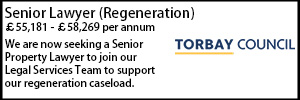Councils could be owed “hundreds of millions of pounds" in business rates following Supreme Court ruling
- Details
Local authorities could be in line for hundreds of millions of pounds in business rates following last week's landmark Supreme Court ruling, the solicitor who acted for the appellant councils has claimed.
However, the solicitor for the respondent companies has in turn suggested that the judgment potentially meant no one was liable for rates.
In Hurstwood Properties (A) Ltd & Ors v Rossendale Borough Council & Anor, Rossendale Borough Council and Wigan Council brought test cases over whether they had reasonable grounds for claiming non-domestic rates (NDR) on certain empty properties from the respondent companies.
Allowing their appeal, the Supreme Court concluded that there was a triable issue whether the respondents remained liable for business rates throughout the duration of the leases and the local authorities’ claims should not be struck out.
According to the Court, the two test cases were representative of 55 other proceedings pending in the Liverpool District Registry of the Chancery Division alone.
Matthew Whyatt of ASW Solicitors, who acted as lead solicitor for the two North West councils, said the "issued claims, whilst varying in amounts, were in the double-figure millions in total. I anticipate that an avalanche of cases will now follow on from our success in the Supreme Court."
Mr Whyatt added: "From the data that I have seen, those additional claims are highly likely to be in the hundreds of millions of pounds.
"During what have been difficult times for local authorities, it is clear that the schemes have deprived numerous local authorities of significant sums for front line services. We are immensely proud to have obtained such a significant victory for our local authority clients, and to the wider local authorities nationally in the fight against abusive avoidance schemes."
However, Chris Perrin, partner at law firm Addleshaw Goddard, which acted for the respondent companies, said the Court had changed the well-established principle that a tenant under a valid lease was automatically the person entitled to possession and therefore the rate payer. "Instead the Court has said that there is a secondary test in that the Court needs to consider the parties' 'real and practical ability to exercise its entitlement to possession'. The outcome of this decision is that the matters will revert back to the High Court for full trials."
He added that it seemed that the decision "potentially means that no one is liable for rates since if, once the facts are determined by the Court, the tenant is not liable neither is the landlord. The reason for this is that where a landlord has granted a valid and subsisting lease (which the Court accepted by striking out the local authorities' arguments of sham) the landlord has no 'real and practical ability' to exercise its entitlement to possession since to do so would be a breach of the lease and open them up to a damages claim from the tenant. Accordingly, this would mean that neither the tenant nor the landlord are liable for rates."
The background to the case was that the respondent property developer, Hurstwood Properties, had been using a rates avoidance scheme which involved granting a short lease of an unoccupied property to a special purpose vehicle (SPV), such that the SPV became the 'owner' and liable to non-domestic rates liability rather than the respondent company. The SPV was then dissolved or put into liquidation to escape rates liability.
Rossendale and Wigan claimed that they were entitled to the unpaid business rates from the respondents, either because the lease to the SPV was ineffective to make the SPV the 'owner' of the unoccupied property under the Local Government Finance Act 1988, applying WT Ramsay Ltd v Inland Revenue Comrs [1982] AC 300 (the statutory interpretation ground), or because the SPV should be ignored, relying on Prest v Petrodel Resources Ltd [2013] UKSC 34 (the 'piercing the corporate veil' ground).
The Supreme Court allowed the councils' appeal on the statutory interpretation ground. In light of this decision, the alternative ground fell away as it depended on the SPVs being ‘owner’. Nonetheless, the Court addressed this ground of appeal and rejected it.
Accordingly, the Supreme Court set aside the order of the judge in so far as he struck out the councils' claims that, on the proper interpretation of sections 45 and 65(1) the 1988 Act, the leases were ineffective to make the SPVs the owners of the relevant properties, with the result that the defendants remained liable for business rates. The Supreme Court left undisturbed the decision of the Court of Appeal in so far as it struck out the claims based on “piercing the corporate veil”.
Adam Carey
Sponsored articles
Walker Morris supports Tower Hamlets Council in first known Remediation Contribution Order application issued by local authority
Unlocking legal talent
Contracts Lawyer
Legal Director - Government and Public Sector
Lawyer (Planning and Regulatory)
Locums
Poll








































